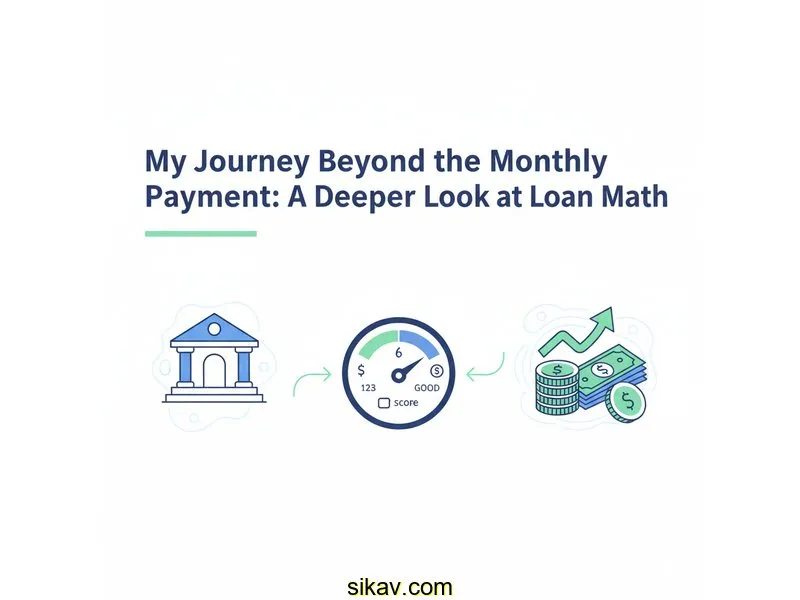
Auto Loan Calculator
Calculate payments over the life of your Loan
Home Blog Privacy Terms About Contact
Calculate payments over the life of your Loan
Home Blog Privacy Terms About ContactPublished on October 15, 2025

It all started with a simple chat. A friend mentioned getting a loan and was pleased with the monthly payment. It sounded surprisingly low for the amount they borrowed. My immediate thought was, "Wow, that's a great deal." But then they mentioned the repayment period, and a small, nagging question popped into my head. How could the payment be so manageable, yet the term felt so long? Was there something I was missing about how these numbers connected?
This wasn't about judging their decision; it was about my own gap in understanding. I realized I’d always looked at loans through a single lens: the monthly payment. It was the number that felt most real, the one that would directly impact a monthly budget. But was it the only number that mattered? Could a lower payment hide a different, larger story within the math?
I decided to spend some time with online loan calculators, not to shop for anything, but to simply play with the numbers. My goal was purely educational. I wanted to see the machine at work, to understand the mechanics behind the curtain. How did changing one input, like the loan's timespan, ripple through all the other results? This is the story of that exploration. This is about understanding how calculations work, not financial advice.
My quest was simple: I wanted to understand the relationship between the monthly figure, the interest rate, and the total duration. I felt like I was looking at three separate dials, and I wanted to learn how turning one affected the others. It was time to stop guessing and start calculating.
Armed with my curiosity, I opened a loan calculator. I decided to build a scenario based on the conversation that started this whole thing. I imagined two different possibilities for the same loan amount to see how the outputs would compare. My initial focus was entirely on that one number: the monthly payment. This was my first mistake, though I didn't know it yet.
First, I created a scenario similar to my friend's: a longer repayment timeline. I entered a loan amount of $11,750 with an interest rate of 6.3% over 72 months. The calculator instantly returned a monthly payment of approximately $195.91. My initial reaction was confirmed—that number felt very manageable. "See," I thought, "that's a good setup."
Next, I wanted to see what would happen with a shorter timeline. I kept the loan amount the same, $11,750, but changed the term to 48 months. For this exercise, I used a slightly lower interest rate of 5.8%, assuming a shorter term might get a better rate. The new monthly payment was $273.74. My brain immediately categorized this as "worse." It was nearly $78 higher each month. My entire analysis, based on my limited understanding, stopped right there.
For a moment, I felt satisfied. My conclusion was that a longer term was clearly the better path because it kept the monthly obligation lower. But that nagging question returned. Why would anyone choose the higher payment? I stared at the calculator's results page, scanning the other fields I had completely ignored: "Total Principal Paid," "Total Interest Paid," and "Total Repayment." It was in these overlooked fields that the real story was hiding.
The turning point came when I forced myself to look away from the monthly payment field. My eyes drifted down to a line item called "Total Interest Paid." When I ran the two scenarios again, this was the number I watched. The results were so stark, so contrary to my initial conclusion, that I felt a jolt of understanding. It was a genuine "aha" moment.
For the first scenario (72 months), the total interest was $2,355.52. For the second scenario (48 months), the total interest was only $1,389.52. The difference was nearly a thousand dollars. The "cheaper" monthly payment was actually leading to a significantly higher overall expense. Suddenly, I realized I hadn't been comparing apples to apples; I had been comparing one part of the story to another part of a completely different story.
The biggest lesson was how dramatically the loan's duration dictates the total interest. A longer term means the principal balance decreases more slowly. With each payment on a longer schedule, a larger portion goes toward interest, especially in the early stages. The calculator allowed me to see this in black and white.
My next step was to do some basic multiplication to solidify my understanding. For the 72-month scenario, I multiplied the payment by the term: $195.91 x 72 months = $14,105.52. For the 48-month scenario, it was $273.74 x 48 months = $13,139.52. Seeing these two "Total Repayment" numbers side-by-side was the final piece of the puzzle. The lower monthly payment led to a total repayment that was almost $1,000 higher.
Many calculators have a feature that shows an amortization schedule or chart. I clicked on this and it was like turning on the lights in a dark room. I could see that for the 72-month loan, the first several payments were heavily weighted toward interest. For the 48-month loan, the principal was being paid down more aggressively from the very beginning. This visual tool was essential for me to grasp why a longer term resulted in more total interest.
To make sure this wasn't a fluke, I ran more tests. What about a middle ground? I tried a 60-month term for the $11,750 at 6.1%. The monthly payment was about $227, and the total interest was around $1,870. It fit perfectly between the other two scenarios. A higher monthly payment than the 72-month option, but lower than the 48-month one. And the total interest was also right in the middle. My confidence grew. I wasn't just plugging in numbers anymore; I was starting to predict the outcomes.
This journey through the numbers taught me several fundamental lessons about calculation literacy. It wasn't about finding a "good" or "bad" loan, but about learning to read the story the numbers were telling. Here's what I now understand:

The total repayment figure includes two components: the original principal (the money you borrowed) and all the interest you pay over the life of the loan. The interest is the amount charged by a lender for providing the funds, so your total payments will always be higher than the initial loan amount.
From a purely mathematical perspective, not necessarily. As my exploration showed, a lower monthly payment is often achieved by extending the repayment term. A longer term provides more time for interest to accrue, which can lead to a higher amount of total interest paid over the life of the loan. It's a trade-off between monthly affordability and total overall numbers.
The term is one of the most significant factors. A shorter term requires you to pay back the principal faster, resulting in higher monthly payments but less total interest. A longer term spreads the principal repayment over more time, leading to smaller monthly payments but more total interest, because the outstanding balance accrues interest for a longer period.
The best way is to experiment. Enter the same loan amount and interest rate, but try different terms (e.g., 36, 48, 60 months). Pay close attention to how the "Monthly Payment" and "Total Interest Paid" fields change with each adjustment. This will give you a clear, numerical picture of the relationship between these variables.
My weekend with loan calculators started with a simple question and ended with a profound sense of clarity. The mystery wasn't in some complex, hidden formula; it was in my own narrow focus. By concentrating only on the monthly payment, I was missing the bigger, more important story. I was reading one page of a book and thinking I knew the ending.
Learning to look at all the numbers—the monthly payment, the term, and especially the total interest—felt like learning a new language. It's a language of trade-offs, where every variable has an impact on the others. I now feel much more equipped to understand the mechanics behind the loans I might encounter in the future.
My encouragement to anyone else curious about this is to do the same: open a calculator and just play. Change the numbers, ask "what if," and watch how the results shift. The goal isn't to make a decision, but to build understanding. The confidence that comes from knowing how the numbers work is a valuable thing in itself.
This article is about understanding calculations and using tools. For financial decisions, always consult a qualified financial professional.
Disclaimer: This article documents my personal journey learning about loan calculations and how to use financial calculators. This is educational content about understanding math and using tools—not financial advice. Actual loan terms, rates, and costs vary based on individual circumstances, creditworthiness, and lender policies. Calculator results are estimates for educational purposes. Always verify calculations with your lender and consult a qualified financial advisor before making any financial decisions.
